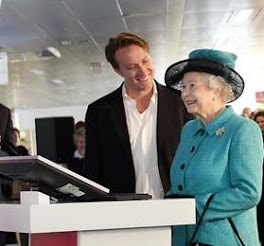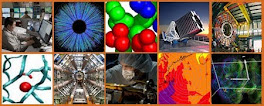Yesterday provided a perfect illustration, leading to today's triumphant post. I was being got at by someone on shroudstory.com, to explain the fingers on the Turin Shroud. When it became increasingly difficult to understand precisely what I was being asked to explain, a sudden thought entered my head - why not do a simple EXPERIMENT to cut through the semantic fog?
Here's the result, reported as an addendum to the previous post.
Yes, they are hand prints, my hands, using a highly sophisticated imprinting medium known only to a tiny, er, handful, of science bods like myself (Nutella chocolate/hazelnut spread).
The image on the left was produced by coating the back of my hand, being careful to go in-between fingers too, then laying cotton sheet on top, then using the other hand to mould fabric to the contours, while all the time KEEPING FINGERS TOGETHER.
The image on the right was produced with reverse geometry: after coating the back of the hand, the hand was then placed back-side DOWN i.e. palm up, onto the cotton, and pressed firmly, without any rocking motion.
It's that second mode of presentation that gives the fascinating result - with an imprint that would have the observer believe that the fingers were thin and bony AND with spaces, ie.air gaps between them, which was not the case.
Close up of the press-down presentation
Now compare with the crossed hands on the Turin Shroud, the fingers of which have been the subject of so much interest (to say nothing of wild speculation),
TS hands: Durante 2002 image from Shroud Scope, with extra contrast in MS Office Picture Manager
Conclusions: 1 The fingers are NOT bony. They are exactly as one would expect if produced as a contact imprint ("impactograph") under applied pressure, modelled as in my Nutella spread experiment.
2. The thumbs are absent for a very simple reason. Place your hand down on a surface with the palm up. Is your thumb touching the surface? Answer: if it's a typical hand, then NO, except the very tip of the thumb maybe.
To think I've been researching the TS for some 30 months, but did not think of doing yesterday's simple experiment before, and only did so when coming under sniper fire.
I love research. While I occasionally brag about new ideas, new results, research teaches one humility - constantly reminding one of limitations to say nothing of mental lacunae, blind spots etc
There was another rewarding discovery today for this science blogger. Some 28 years ago he published the very first research paper in the peer-reviewed science literature devoted specifically to "resistant starch", arguing that it should be regarded as a legitimate contribution to dietary fibre (which brought him into conflict not just with other scientists but his own paymasters at the then Ministry of Agriculture, Fisheries and Food, "MAFF" for short).
Abstract:
Heat processed foods can contain appreciable amounts of resistant starch (RS) that have the ability to survive prolonged incubation with alpha-amylase and other amylolytic enzymes. The occurrence of RS has important implications for dietary fibre (DF) determination and, possibly, for human bowel physiology also. Studies using cereal and potato starches have identified three key factors that influence yields of RS after heat-processing, ie amylose content, processing temperature and water content. The highest yields of RS (20-34% of total dry weight) were obtained from amylomaize starches, either raw or processed, and from amylopectin starches (32-46% RS) after incubation with alpha -(1->6)de-branching enzyme (pullulanase) followed by heat-processing. In contrast, the lowest yields of RS (0.2-4.2%) were obtained from intact (ie non-debranched amylopectins), with or without heat-processing. Yields of RS from wheat starch were affected primarily by processing temperature, reaching levels of about 9% in a single cycle of autoclaving at 134°C with excess water and subsequent cooling (cf levels of less than 1% in uncooked wheat starch) and higher levels still (about 15%) after 5 repeated cycles of autoclaving and cooling. A similar increase in yields of RS was seen in dilute (1%) starch suspensions that were subjected to repeated cycles of heating to 100°C, followed by cooling and storage. The time of storage after gelatinisation was only important in these dilute systems: levels of RS in freshly-prepared concentrated starch gels(typically 57-67% H20) or in white bread did not alter significantly on storage.
There was one interview with the Independent's science correspondent (John Emsley) on his home ground at Kings College London, way back in 86. But resistant starch never really attracted the attention of the UK media, until that is TODAY. Hooray. Yes, there's a front page article in the Daily Mail that not only mentions resistant starch, but advises people to select foods high in RS (green bananas etc). Steady on chaps.
In fact the write-up, indeed quoted words from the Liverpool expert, are not quite right as regards detail. One can't describe resistant starch (RS) as "soluble dietary fibre", since it's a form of insoluble re-crystallized starch (it's reckoned to be linear short chain double helical starch fragments). But it does behave like soluble DF, inasmuch as it is easily fermented in the lower bowel, and much importance attaches to the fact that is becomes degraded partly to the 4-carbon butyric acid that, unusually, is a metabolic fuel for the epithelial cells lining the bowel, a splendid example of symbiosis, possibly, probably associated with protection against bowel cancer.
Incidentally, the successors to MAFF recently agreed that resistant starch IS dietary fibre, and has stated that during a transition period when people are still using analytical methods for dietary fibre that fail to measure resistant starch, they must incorporate a "fudge factor" that estimates the resistant starch as part of total DF for labelling purposes. But why has it taken 30 years for that to happen. despite the EURESTA (European Resistant Starch) inter-laboratory collaborative studies and other work that showed years ago that RS behaves as DF. It's because people get wedded to ideas and can't let them go, even when confronted with overwhelming evidence to the contrary. That I'm afraid is the downside to science, and why I for one would never encourage any school leaver to make a career in specialist scientific research, at least in the UK with its media and even public antipathy to science and scientists (don't get me started).
Late addition: Tuesday 23:00
Have just spotted this quote from Professor Giulio Fanti that he made in the course of an interview with shroudstory.com regular "Louis", or to give the latter his full name (supplied on that posting): Louis C. de Figueiredo
"Radiation has been proposed
as the source of the body image because we know that the image also resides where body-cloth
contact is not possible, for example in the zone between the nose and the cheek or between the hands and the
belly, therefore I agree with it."
The question of contact v non-contact areas between cloth and 'body' is one that readers of my blog will know has occupied me greatly in the course of the last few postings. It's crucial to my belief that the TS image is best described as an impactograph, or more simply, a pressure imprint, the imprinting medium and/or energy source being a matter for conjecture. So here we have one of shroudology's most celebrated authenticity-exponents attempting to dismiss contact imprinting in a sentence or two, referring to just two specific sites on the TS frontal image.
Do these words stand up to close scrutiny?
I say no, and for the following reasons:
First point: quote: "body-cloth contact not
possible in the zone between the nose and the cheek" ? Does that refer to a cloth
that is loosely draped over the face such that there is ‘tenting’ from the
bridge of the nose to the cheek bone, creating an air gap?
But who says that cloth is loosely
draped? Given the radiocarbon dating one
has to at least acknowledge the possibility that the image WAS made by human
hands. Whatever the nature of the imprinting
process, it would have lacked for detail if the material had carelessly been allowed
to tent (i.e. shortcut) between prominences. So a conscious effort would have been made to
ensure there was moulding of fabric around important contours.
Now there are two
ways that could be achieved in the case of the frontal body, face included. One
is to press the subject down into linen, with some kind of soft underlay, such
that fabric conforms to relief better than would be the case if simply draped
over the top. The second, leaving nothing to chance, is to place linen on top
of subject and then use fingers to manually press and mould the fabric around all the important contours.
Here's a series of progressive enlargements of the nose are, starting with the high resolution Face Only option in Shroud Scope, with additional contrast (-7,100,0 Brightness/Contrast/Midtone value in MS Office Picture Manager):
Here's a series of progressive enlargements of the nose are, starting with the high resolution Face Only option in Shroud Scope, with additional contrast (-7,100,0 Brightness/Contrast/Midtone value in MS Office Picture Manager):
Here, for the sake of completeness, is the first in the series after light/dark inversion in ImageJ:
I'd have added a 3D photo-edit from ImageJ, but there was scarcely any useful or photogenic enhancement of the above picture. Indeed the end-result seemed to be artefactual distortion more than anything else.
What do these pictures tell us, if anything, about the extent of tenting between bridge of nose and cheek?
ed: I'll need some time to think about that - expect to see some extra words added here later today (message timed at 06:38 Wed 16 July)
07:11 Back again. Frankly I fail to see why Fanti has drawn particular attention to the imaging of the nose and its immediate surrounds. I think the nose looks somewhat wider, dare one say impacted, than might a real nose in a real photograph, but that has to be conjecture, not having seen the subject in life, or death for that matter. Looking at the series of enlargements, the only sound conclusion would be that the imaging of the nose results in a fairly homogenous distribution of pixels that incorporates little information content as to the 3D nature of the original subject, and indeed the 2D image responded poorly to ImageJ in its 3D mode.
My overall conclusion: the nose tells one nothing about the likely mechanism of imaging - whether imprinted by direct contact or by that 'mysterious' unspecified radiation. If Professor Fanti thinks it does, then he should explain his thinking in greater detail, since it's not in my view self-evident despite having accumulated hours, nay days or even weeks of poring over and scrutinizing closely Shroud Scope images.
Second point: image “also resides between
hands and belly”?
Really? The predominant impression one gets from looking at
positive images is surely the low image intensity in and around the crossed
hands, suggesting in this instance that tenting did occur (or was tolerated),
whether the linen was underneath or on top of the subject.
I've shown Shroud Scope images previously, with captions that draw the viewer's attention to pale zones in the lower abdominal area around the crossed hands.
So at to leave no doubt in the viewer's mind. I've just this minute entered the same graphic into MS Office Picture Manager, first setting the brightness/contrast/midtone value to my preferred standard values (-7,100,15), and then, keeping the first two numbers constant, steadily decreasing the midtone intensity, a device for delineating zones of exceptionally high image intensity.
Here's the sequence:
 | ||
| -7,100,15 |
 |
| -7,100,0 |
 |
| -7,100,-19 |
 |
| -7,100,-42 |
 |
| -7,100,-61 |
There seems little doubt that there is indeed a pale, poorly imaged zone around those crossed hands. The belly region contiguous to those crossed hands is not, repeat NOT well imaged as claimed by Giulio Fanti. The fact it is not well imaged is precisely what is expected of a contact model , with the minor qualifying assumption that unlike the nasal region earlier, no deliberate attempt was made on this occasion to image around the crossed hands, as might have been possible in the Linen-On-Top procedure.It's a large area, and any attempt at moulding on and around those crossed hands risked rucking the fabric, producing unsightly creases.































No comments:
Post a Comment